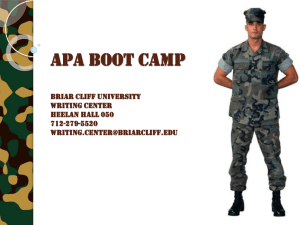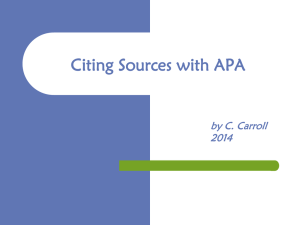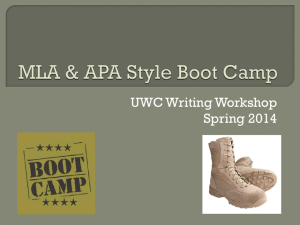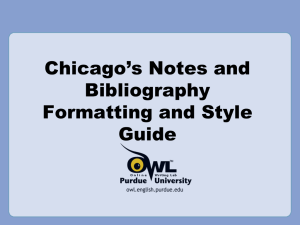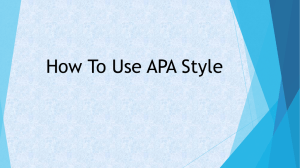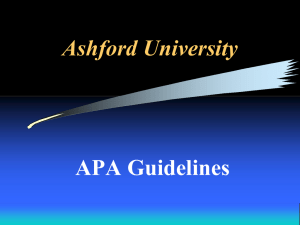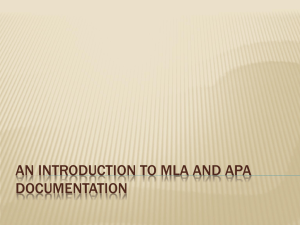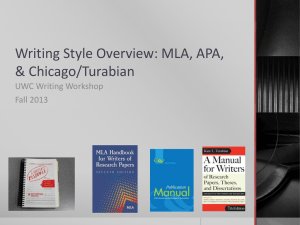APA Style: An Introduction
advertisement
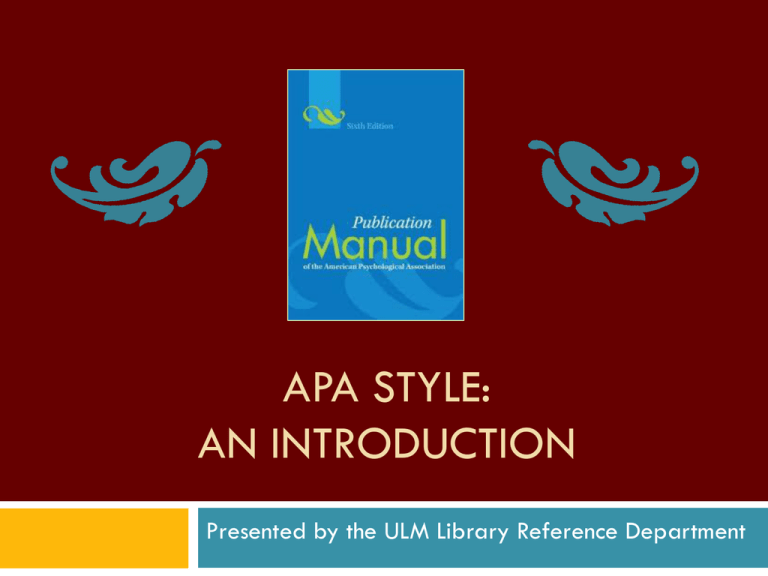
APA STYLE: AN INTRODUCTION Presented by the ULM Library Reference Department Session Overview What is APA style? General Guidelines The Basics Parts of a Paper Citations Footnotes + Endnotes Resources Q & A Time What Is APA Style? a set of rules intended to encourage and maintain clear, concise writing provides guidelines for formatting papers used to create citations for resources primarily used by the social sciences, but other sciences use it as well (like nursing, for example) What Is APA Style, Continued Like any style format, it is intended to establish and maintain consistency and quality in research It also supports scholarly communication by facilitating documentation, i.e., it demonstrates a common way of citing sources so other scholars can consult the resources you used So You Will Use It To… Format your paper, including… Margins Spacing Font selection and size Headers Guide the style of your paper, including… Voice Word choice Removing bias General Guidelines 1-inch margins on all sides Double-spaced 10-12 point font Times New Roman or a similar font i.e., something very plain and professional Examples: Arial, Century Gothic, or Garamond Page headers Running header Includes page numbers and author’s name The Basics 3rd person voice is the preferred way to write: “The researcher found…” If the paper is co-authored, you can use “we”: “We found in the course…” Avoid the passive voice; use the active voice Use language that is professional; avoid poetic or flowery language Be as concise as possible The Basics, Continued Word choice is very important; the OWL at Purdue highlights the following points: Use terms like "participants" or "respondents" (rather than "subjects") to indicate how individuals were involved in your research Use terms like "children" or "community members" to provide more detail about who was participating in the study Use phrases like "The evidence suggests ..." or "Our study indicates ..." rather than referring to "proof" or "proves" because no single study can prove a theory or hypothesis The Basics, Continued APA addresses headings within papers in the following way: This image was taken from the OWL at Purdue website. The Basics, Continued Seriation – that is, lists – are permitted in APA style You can use numbered listing; in the case of this kind of listing, items should have ending punctuation Bulleted lists – where hierarchy is not important – should also have ending punctuation Seriation within sentences should use letters: (a) point one, (b) point two, and (c) so forth The Basics, Continued Literature review type papers contain: Title page Introduction List of references Experimental/report type papers typically contain: title page abstract introduction method results discussion references appendixes (if necessary) tables and/or figures (if necessary) The Basics, Continued Avoiding bias is important in APA style; word choice is one means of avoiding bias in one’s paper Bias, in this case, is used to refer mainly to various elements within a population The three main areas in which this is an issue are: Disability Race & Ethnicity Sexuality The Basics, Continued Avoid gendered pronouns; the OWL at Purdue recommends: Rephrase the sentence Use plural nouns or plural pronouns - this way you can use "they" or "their" Replace the pronoun with an article - instead of "his," use "the" Drop the pronoun - many sentences sound fine if you just omit the troublesome "his" from the sentence Replace the pronoun with a noun such as "person," "individual," "child," "researcher," etc. The Basics, Continued Find alternative descriptors, and avoid using labels Use adjectives that are genuinely descriptive; consider the parameters of your study Example: instead of saying “amnesiacs” say “amnesic patients” or “people diagnosed with amnesia” Parts of a Paper There are four (4) major sections to a reportstyle APA paper… 1. 2. 3. 4. Title page Abstract (should include keywords) Main Body References Think of It Like This… Title page = head Abstract = arms Body = body References = legs Part 1: Title Page The Title Page should contain… Running head + page number Title Author Author affiliation Running Head Created using “Insert Header” Is the title of your paper Left-aligned On Title page, will include the words “Running header” On subsequent pages, will only include the title Title Information The title part of the page should be located in the upper half of the page, in upper and lower case letters Ideally the title should be no more than 12 words long and contain no abbreviations; it can take up two lines The title should be double-spaced as well It should look like this… This image was taken from the OWL at Purdue website. Part 2: Abstract (+ keywords) The abstract will start on a new page Center the word “Abstract” Do not indent the paragraph Should be between 150-250 words Is meant to be a concise summary of the contents of the main body Below the abstract, indented, you may include a keywords section; italicize “Keyword,” insert a colon, and list the keywords It should look like this… This image was taken from the OWL at Purdue website. Part 3: Main Body This is the tough part – the research part. The part *you* generate Remember: there are 2 types of papers in APA A literature review Experimental/report A report is going to be much more in-depth and will include a literature review Main Body, Continued The main body will include a running header on all pages; page numbers should be in the upper righthanded corner The first page will contain the title again, centered, but not bolded, underlined, or italicized Level 1 headings should be left flush and bolded In-text citations (also called parenthetical citations) will usually contain the author’s name and the date of publication (more on that in a minute) It should look like this… This image was taken from the OWL at Purdue website. In-text Citations These are used to cite resources within the text Every in-text citation will have a corresponding citation in the References section If you quote something directly from a text, then the citation will include author name, date of publication, and page number (sometimes) In-text Citations, Continued If you paraphrase something, the in-text citation will only contain the author’s name and the date of publication If you use the author’s name in the course of the sentence, that name will not appear in the in-text citation In-text Citations, Continued Direct quotation, author named in sentence According to Jones (1998), "Students often had difficulty using APA style, especially when it was their first time" (p. 199). In-text Citations, Continued Direct quotation, author not named in sentence According to some researchers, "Students often had difficulty using APA style, especially when it was their first time" (Jones, 1998, p. 199). In-text Citations, Continued Long (40+ words) quotations should be set apart (that is, not within the text, like a block quotation) Omit quotation marks Indent five spaces from margin Maintain double spacing BLAH Same rules apply for in-text citation, EXCEPT that the quotation will end with its punctuation, then followed by the citation In-text Citations, Continued Long direct quotation Jones's (1998) study found the following: Students often had difficulty using APA style, especially when it was their first time citing sources. This difficulty could be attributed to the fact that many students failed to purchase a style manual or to ask their teacher for help. (p. 199) In-text Citations, Continued Even if you’re paraphrasing something, you’ll still need to identify the original source In-text citations work for paraphrasing, too The in-text citations will only include the author’s name and date of publication; you can include page numbers at your discretion In-text Citations, Continued Paraphrasing in-text citations According to Jones (1998), APA style is a difficult citation format for firsttime learners. APA style is a difficult citation format for first-time learners (Jones, 1998, p. 199). Part 4: References On the References page: center the title “References” at the top of the page Remember: if you have an in-text citation, you will have a corresponding bibliographic citation in your references References are double-spaced, too References, Continued All lines following the first line of the citation will be indented a one half-inch from the margin (also known as a hanging indent) Italicize titles of long works, like books or journal titles Do not put quotation marks around the titles of short works, like essays or articles References, Continued Author names are inverted; that is, last name first. APA does not require the spelling out of first names; initials are sufficient Regardless of how many authors a source has, all author names will be last name first If a source does not have an author, it will be alphabetized based on title References, Continued Book Zimbardo, P.G. (1977). Shyness: What it is, what to do about it. Cambridge, Mass.: Perseus Books. Essay/Chapter in a Book O'Neil, J. M., & Egan, J. (1992). Men's and women's gender role journeys: Metaphor for healing, transition, and transformation. In B. R. Wainrib (Ed.), Gender issues across the life cycle (pp. 107-123). New York: Springer. References, Continued Article Scruton, R. (1996). The eclipse of listening. The New Criterion, 15(30), 5-13. Article from a Database APA style does not require that a citation for an article in a database document that fact. You can cite an article you find in a database the same way you’d cite a regular print article, as in the example above. References, Continued Website Lowe, M. (2008). Megan Lowe @ ULM. Retrieved from http://www.ulm./edu/~lowe Unknown Author Merriam-Webster's collegiate dictionary (10th ed.). (1993). Springfield, MA: Merriam-Webster. Footnotes + Endnotes APA prefers that authors avoid footnotes and endnotes; however, sometimes notes are necessary APA identifies two types of notes: content and copyright You will use superscript numbers (like this²) Superscript numbers can follow any punctuation EXCEPT dashes Footnotes + Endnotes, Continued If using the footnotes function of a word processing program like MS Word, all footnotes should be at the bottom of the page on which they appear They may also follow the References page (this would make them endnotes); on their page, center the title “Endnotes” Footnotes + Endnotes, Continued Notes should be double-spaced, regardless of where they appear Indent five (5) spaces from the superscript number when composing the note; all subsequent lines do not have to be indented If a note falls in parentheses, the superscript number should be within the parentheses, too Footnotes + Endnotes, Continued Content notes provide supplemental information Content notes can also direct readers to additional information that the author may not mention in the main body Content notes should be brief, a small paragraph at most, and should focus on one issue or subject Footnotes + Endnotes, Continued Copyright notes contain copyright permissions If you quote more than 500 words of published material or think you may be exceeding fair use, you will need to get permission from the original author(s) Formatting works the same as content notes Permission letters will need to be attached to the report APA Style Resources The OWL at Purdue, APA Style Guide http://owl.english.purdue.edu/owl/section/2/10/ APA Style Site http://www.apastyle.org/ APA Reference Style Guide http://library.nmu.edu/guides/userguides/style_apa.htm The Library has a copy of the manual at the Reserves Desk at Circulation on the first floor Question & Answer Time Thanks for your attendance! Remember, if you need research help, all you have to do is ask the librarians. You can… Visit the Reference Desk, Library 1st floor Email us at reference@ulm.edu Call us at (318) 342-1071

